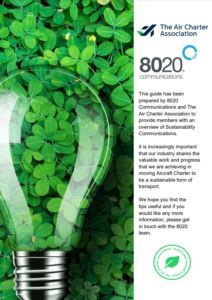Sustainability Communications Guide
It is increasingly important that our industry shares the valuable work and progress that we are achieving in moving Aircraft Charter to be a sustainable form of transport.
The ACA Guide To Sustainability Communications
Good environmental conduct is no longer a ‘nice to have’ and for private charter to continue to thrive it’s becoming a business imperative to have sustainable initiatives in place.
There is now mass public awareness of the climate crisis due to the actions of activist groups like Extinction Rebellion. Celebrity and HNWI jets are being tracked and used as examples of how private aviation is perceived as doing nothing to reduce its impact on the environment. The industry needs to be able to demonstrate and communicate its commitment to sustainable environmental conduct and it is our shared responsibility to educate and encourage customers to make sustainable choices.
As a result of increased public awareness, more companies are being held to account, making communicating sustainability actions increasingly important. It can be overwhelming to know where to begin and this guide provides a starting point.
This guide has been prepared by 8020 Communications and The Air Charter Association to provide members with an overview of Sustainability Communications.
We hope you find the tips useful and if you would like any more information, please get in touch with the 8020 team.
Five tips on sustainability communications
1) Establish your sustainability strategy or roadmap
You may be at the outset of your sustainability journey or already have an action plan in place. Either way, to communicate with substance about your company’s role in decarbonising aviation, having a roadmap or strategy provides a tangible place for your teams to turn and understand your company’s objectives for sustainability and how you will meet them.
If you don’t know how to begin there are specialist businesses that can offer advice on setting a sustainability strategy, such as our sustainability partner, 4AIR.
2) Communications Plan – Engage, Influence and Educate
Once your sustainability plan is in place communicating your work is very important both for your company’s environmental position, the wider industry and educating customers and suppliers. You therefore need to translate your sustainability plan into your wider communications plan. For example, you may now be offering the option of Sustainable Aviation Fuel with every flight or have implemented The ACA member carbon offsetting scheme with 4AIR. These actions should be included within your communications strategy and diarised to provide regular content throughout the year.
3) News media vs owned media
From your long-term sustainability plan, only announce to the news media the key milestones in your programme (via press releases or journalist briefings). To do more risks over-saturating your news flow and reducing the impact of your actions. Appropriate examples could include all your flights now being carbon neutral, or the results of a sustainability research project you may have carried out.
Smaller acts within the sustainability plan can be communicated about on your own social media channels. For more advice about how to showcase your sustainability efforts on social media, watch this video: https://www.8020comms.com/sustainability-how-to-showcase-your-efforts-on-social-media/
4) Avoid greenwashing
As with implementing anything new in your business, sustainability actions need to be tied to specific business objectives. This makes it easier to avoid greenwashing, and prove you are genuinely concerned about environmental and social challenges and are addressing them in a meaningful way. Greenwash can also be created by a lack of clarity when making statements about your sustainability actions so be very clear about which metrics you are using.
For example, if you are offsetting your flights by 200% you need to establish whether this is 200% of direct carbon emissions or 200% of all emissions for the flight (sometimes referred to as 200% Co2e+). There is a big difference between the two. Best practice also requires you stating what certification the offset scheme is covered by. Finally, be careful with the terminology you use: ‘Carbon Neutral’ as a goal is very different to ‘Net Zero’.
‘What is greenwashing?’
“Greenwash or greenwashing describe when companies or people deliberately mislead or misrepresent to external stakeholders an interest in protecting the natural environment, when no such interest exists.” Any form of greenwashing de-values the huge efforts and investment our industry is making in the move towards sustainability and must be avoided at all costs.
5) Advocating Change: Become a champion for your industry
Sustainability communications don’t have to stop with what you’re doing. For sustainable actions to have true impact they need to influence others to follow suit. Consider where your company’s actions can have the most sway, such as speaking at events or joining industry bodies. For example, The Air Charter Association’s working group on Sustainability and Innovation.
Conclusion
The spotlight is firmly on private aviation as a significant contributor to global carbon emissions. It is therefore easy to be swept up by one scheme or make a rash decision because you feel the need to ‘do something’. Instead, taking the time to develop a sustainability strategy and communicating about it will reassure your customers, retain your staff, and attract new talent. It will also ensure your business stays relevant for years to come.



